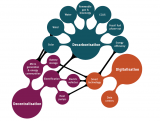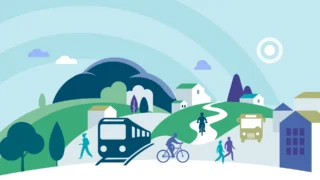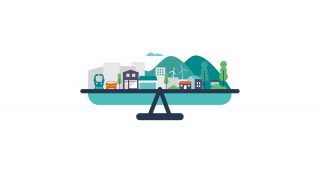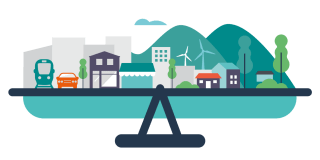As we move towards a lower carbon society one of the key trends will be increased electrification and using renewable electricity to fuel our heat and transport. This will involve very significant changes in how we consume and are supplied with electricity in our homes. Following the recent post on electricity use, some issues of supply, including generation, distribution and transmission, as they relate to rural dwellers, are considered in this post.
This is part of a continuing series focussing on issues for rural dwellers in relation to climate action and the move to low carbon region. Previous posts in this series have provided an overview (for example here and here) of some of the issues for rural people in the Western Region in their transition to a low carbon society. Posts have also covered heat in our homes and energy efficiency and retrofit , and transport, why we travel and what we know about travel in the Western Region and our use of electricity in the home. In these we are looking at rural dwellers, rather than the broader rural economy which would include agriculture and enterprise, and the focus of this WDC work is on the way we use energy, in its different modes, as part of our daily lives.
Changes expected in the electricity system
There are significant changes expected in the ways we will generate, store, transmit, distribute and use electricity in the coming decades. Many of these will impact on rural life, providing opportunities for rural dwellers or changing the way we use energy. The illustration below (from EirGrid’s Tomorrow’s Energy Scenarios) shows many of the areas of change and how they link with each other. Decarbonisation will change the generation portfolio with increased renewable generation and a phase out of fossil fuel generation alongside more efficiency in how we use and transmit electricity.

Figure 1: The influence of decarbonisation, decentralisation and digitalisation on the future electricity system
Source: EirGrid, 2019, Tomorrow’s Energy Scenarios pg. 31
Decentralisation is another aspect of the change in generation with a move from fewer, large scale generators to a more dispersed system with smaller generation sites and microgeneration by homes and businesses. Generation will often be closer to the site of consumption, sometimes at small scale, including domestic level, and storage options will become more important. Finally the digitalisation of systems using smart technology will provide for differ control methods and consumption decisions based on price, carbon intensity and other issues important to the user.
Opportunities for rural dwellers – electricity generation
These changes provide opportunities for those rural dwellers who can afford it to become involved at the individual home scale, at community level and as shareholders in the commercial generation projects.
Rural areas are, and will be, the site of most electricity generation and with the move to more renewables, the location of generation will often follow the resources to areas with most wind or potential for solar generation. This means that some rural dwellers are, and more will be, living in proximity to wind and solar farms and the infrastructure needed to transmit and distribute electricity from them. This has, on occasion, given rise to concerns from rural dwellers and difficulties in ensuring our electricity infrastructure is built in a timely manner. It is to be hoped that improved ways of consulting, planning and building such as EirGrid’s new strategy to 2025, new wind energy guidelines (the draft is published, consultation open to 19.02.20) and the new Renewable Electricity Support Scheme (RESS) will allow people living in rural areas to contribute to the planning and development of renewable electricity generation in their areas and to benefit from the investments in their locality (opportunities in the proposed RESS is discussed in more detail below).
At a small scale there are significant opportunities for rural dwellers to become involved in microgeneration. Installing solar panels for electricity generation or solar thermal systems for water heating are likely to be the best options but small scale hydro and wind may be installed where the conditions are good. More information about grants from SEAI for solar electricity (PV) is available here and information about solar water heating grant is here.
The microgeneration of electricity can be for ‘self-consumption’ purposes, with the electricity generated first going to power home appliances, electric heating systems (such as heat pumps) and to charge EVs. Electricity generated can also be stored for use later —perhaps after sunset in the case of solar— in batteries, including those in EVs or in other energy forms such as hot water and in heating systems. Finally, excess electricity generated can be exported into the national electricity grid. In many other places, Germany and the UK for example, the householder is paid for this electricity (there are a variety of possible mechanisms including a feed in tariff) but in Ireland this is not common policy (the exception being Electric Ireland which has a microgeneration pilot scheme for existing customers). The Climate Action Plan, however, commits to the launch of a finalised policy and pricing support regime for micro-generation (under Action 30) which will mean householders will be paid for the electricity they produce and do not use themselves. In future domestically generated electricity may be provided to other electricity users. Thus many rural dwellers who live in detached, unshaded houses, and who have capital to invest, are in a good position to become involved in electricity generation.
At a community level, there are also options for rural areas (and other places) to become involved in the Sustainable Energy Community (SEC) network. There are currently over 350 communities in the network with a target of increasing this to 1,500 in the Climate Action Plan. As well as householders the SEC can include a range of different energy users such as homeowners, sports clubs, community centres, local businesses and churches. Each community develops an energy use masterplan covering all aspects of energy use and resources. The focus is not just on electricity but on increasing the efficiency and sustainability of all energy use.
In order to increase local participation in electricity generation it is proposed that the new Renewable Electricity Support Scheme (RESS) will have a specific strand for projects with a majority community ownership and whose primary purpose is community benefit (environmental, economic or social) rather than financial profit. In addition to this option[1], every project developer will be obliged to contribute to a Community Benefit Fund at a rate of €2 per MWh every year (which could be more than €200,000 annually for a community from a 40 MW wind farm) and a community investment scheme (with a Renewable Electricity Participation offering of 5%[2]) allowing people to invest in their local project (and more broadly where it is not fully subscribed locally). A key objective of the support scheme is to ensure more local involvement in generation projects (either community projects or as shareholders in projects developed by others) through these mechanisms. This scheme is currently in development and awaiting EU approval so some elements may change (see here for more information) but it should provide opportunities for rural people to share the benefits of the move to greater electrification and renewable generation in rural Ireland.
The future: electricity distribution and transmission
The dispersed rural population means that Ireland has four times the European average of length of network per capita[3]. The electricity distribution network is the low voltage used to supply electricity to 2.3m customers, including rural households, and to connect small scale generation and microgeneration. It is being developed to make it ready for a lower carbon energy future with the move to a ‘smart network’ (read more here). This includes smart metering which will allow customers to become more actively involved in managing their electricity, delivering benefits for themselves and the wider system. The phased rollout across Ireland is targeted to deliver 250,000 new meters by the end of 2020, beginning in counties Cork and Laois and Kildare from September 2019. It is expected that from 2021 electricity supply companies will begin to offer new smart products and services which will enable households to shift some consumption to times of the day when electricity is cheaper. Households will also be able to gain a better understanding of how and when they are consuming electricity and to manage their use, reducing consumption and in the longer term to take advantage of cheaper pricing times.
Of course, in reality, people have different capacities to engage with detailed management of their electricity consumption. While some of this will in future be integrated into the appliances being used, it is important that pricing and electricity management structures do not significantly disadvantage those consumers using older equipment, with less money to invest in more expensive electricity appliances, or who are less able to engage with and respond to the information provided by smart meters.
The Climate Action Plan target for 70% of electricity to be generated from renewable sources by 2030 means that up to 10,000 megawatts of additional renewable generation, mainly from rural areas, will need to be connected to the electricity system[4]. EirGrid’s stated goal is to achieve the required increase in renewables while minimising the addition of new infrastructure, but there will have to be an increase in the large-scale infrastructure of pylons, substations and overhead wires. The way that these are rolled out across Ireland and the engagement with those living in areas affected by it will be important. While the need to resolve the climate crisis provides an urgent rationale for investment, and the shift to renewable energy has important benefits for our society, locally, nationally and globally, it is important that the benefits of the investment and infrastructure are shared with rural areas and that there is a true participative approach to consulting, planning and building the required network.
Conclusion
The potential for rural householders to become involved in electricity supply was considered in this post, alongside some of the changes in how electricity will be generated and supplied across the country. The need to act in the climate crisis and move to a low carbon Region is clear. Greater use of renewable electricity will be an important part of that. Rural dwellers have a role to play in this, in terms of making contribution to electricity supply, through microgeneration and involvement in community renewable electricity generation projects, or as shareholders in other renewable projects. Rural areas are the site of most renewable generation and the infrastructure associated with it, so the rural areas where the infrastructure is located need to benefit from it, not only in terms of sharing the commitment to addressing the climate crisis, but also in terms of economic benefits and community gain and perhaps most importantly as a means of increasing employment in rural communities.
This series of posts examining the issues for rural dwellers and our region in relation to improving our energy efficiency and use of energy, forms an important part of the work of the Western Development Commission under Action 160 of the Climate Action Plan. The next stage of this work is to bring the analysis of the different energy modes together and to give further consideration to the changes needed and the policy required so that people living in rural areas, in our region in particular, are a part of the move to the low carbon society.
Helen McHenry
[1] https://www.dccae.gov.ie/en-ie/energy/consultations/Pages/Public-Consultation-on-the-Draft-RESS-Terms-and-Conditions.aspx
[2] https://www.dccae.gov.ie/en-ie/energy/consultations/Documents/47/consultations/RESS%201%20Draft%20Terms%20and%20Conditions.pdf
[3] ESB Networks 2027 Lighting the way to a better energy future
[4] EirGrid Strategy 2020-2025, Transforming the Power System for Future Generations





